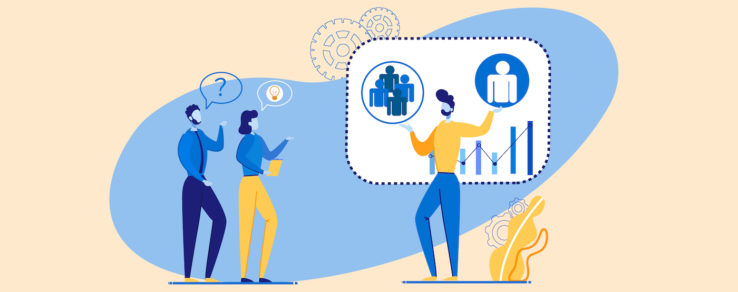Segmentation. What is it and why does it matter? Before we get there, let’s talk about movies.
Brian Lindamood, VP of Marketing & Content Strategy, shared this example to begin the conversation during Questline Digital’s webinar. “If we were to put up a poll asking all of us what our favorite movie is, I bet we would get 100 different answers. And that would be interesting, but not really that useful.”
However, if we instead polled 100 people on their favorite movie genres, we might end up with a response like so:
- 10% romantic comedies
- 10% dramas
- 5% vampire movies
- 75% science fiction
By polling genres, Lindamood explains, “We can see the trends, we can see the meaning in this seemingly random group of 100 people. That’s what customer segmentation is. By identifying the interests of your customers, by identifying their motivation and then organizing them into groups or segments, we can act on that information.”
Who? What? Why?
By definition, segmentation is the process of dividing something into parts or segments. As it relates to energy utilities, segmentation is a best-practice solution to maximize the impact of program promotions, eNewsletters and other communications. By utilizing segmentation strategies, your energy utility focuses on sending relevant messages to targeted groups based on the motivations and interests of your customers.
During the webinar, we asked the audience to share their energy utility’s primary goal with segmentation. Responses showed that 36% wanted to increase customer engagement, followed by a tie of 24% to increase customer satisfaction and increase program conversions.
Luckily, segmentation can accomplish all of these goals. As Lindamood shared, segmentation can lead to:
- More effective marketing messages
- Higher engagement rates
- Increased program conversions
- Building customer satisfaction through stronger digital relationships
More importantly, it also meets customer expectations. As tech giants Netflix, Amazon and Google continue to segment and personalize communications to their customers, these same customers begin expecting this from all of their brands, including their energy provider.
Lindamood reinforced that segmentation is not to be confused with personalization, although the two sometimes go hand-in-hand. Whereas segmentation sends different messages to specified groups, personalization sends a unique message to each individual customer.
Behavioral messages may also be part of a segmentation strategy but differ slightly. These are messages that are automatically triggered by customer actions. Behavioral emails allow you to identify what your customer is interested in and follow up with related information, such as providing relevant program information after a customer reads a related newsletter article.
For energy utilities, segmentation opportunities are boundless. A few campaigns to begin experimenting with a segmentation strategy include:
- Paperless billing campaigns: Address the motivations of each segment and the benefits of switching to e-Bill
- Energy utility marketplaces: Target users with specific items or offer related products
- Welcome Series: Segment communications by residential, business or new and moving customers
- eNewsletters: Residential newsletters based on interests like EV or smart homes; business newsletters segmented by industry
Artificial Intelligence-Driven Personas
Alison Alvarez, CEO & Cofounder of BlastPoint, joined the conversation to share advanced tactics in creating a segmentation strategy, including using AI-driven personas. These predictive models learn from past behavior and anticipate what’s going to happen in the future, helping utilities to better engage with their customers.
“The whole idea of AI-driven personas is to take advantage of the data that you have and find new sources of value in them and make them work smarter, not harder,” Alvarez says. “You can engage with your customers as they grow and change throughout their lifetime.” A key point in Alvarez’s discussion was that you don’t need perfect data to get started. AI helps to simplify the data you have and identify trends you otherwise may be missing.
When it comes to segmentation, she was also clear in sharing that segmentation can be as broad as your entire customer base or as narrow as groups that are best fit for a particular product, service or program.
To create and utilize data-driven personas, Alvarez shared BlastPoint’s process:
- Establish goals: What does your energy utility need to accomplish? What benchmarks do you want to surpass?
- Unlock the power of data: AI-driven analysis to discover what data can be unlocked to reach your specific customers.
- Meet your personas: Utilize custom reports to meet and understand your audience personas.
- Supercharge your initiatives: Learn how to best utilize the data and personas across your organization, whether with marketing, sales or product operations teams.
- Win big: Understand the journey your customers are on and be ready to talk to them where they are in their journey. In turn, you’ll boost engagement and optimize the use of your data.
- Refresh and repeat: Never stop learning and continue engaging customers effectively as their circumstances change.
Segmentation Builds Customer Relationships
Segmentation allows your energy utility to develop a long-lasting personal relationship with customers. “You’re not just going to talk to them one time. You’re not just going to have one touchpoint,” Alvarez says. “If you’re really successful at what you’re doing, you’re going to have a relationship with customers and they are going to come back to you continuously. It’s about taking every point of contact with that customer and making it the best point of contact.”
Segmentation doesn’t have to be as complicated as it may sound. With the right technology, tools and experts, your energy utility can create a segmentation strategy to reach and engage with customers from every audience.

